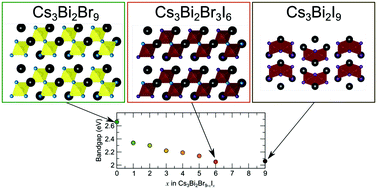Anionic order and band gap engineering in vacancy ordered triple perovskites†
Abstract
We demonstrate that the optical absorption of the vacancy-ordered triple perovskite, Cs3Bi2Br9, can be significantly red-shifted by substituting Br with I while maintaining the layered structural topology. We also present evidence that Br ions prefer to occupy the bridging halide position within the layers in order to minimize strain within the lattice that results from the incorporation of the significantly larger iodide anions into the lattice. These results not only quantify the upper limit for I content in the layered polymorph, but also establish the minimum band gap obtainable from these Bi-based phases.

- This article is part of the themed collection: Perovskites


 Please wait while we load your content...
Please wait while we load your content...